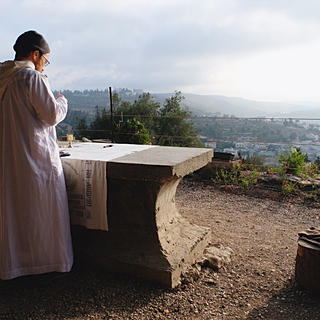Tombs of the Patriarchs and St. Mariam
- beatitudesmissions
- Dec 5, 2017
- 3 min read
As Christians, we are blessed to have so many places here in the Holy Land that help us to form a more concrete experience of Sacred Scripture. However, most Christian pilgrimages focus primarily on New Testament sites. The duration of the Immersion program allows us to visit sites that other Christian pilgrims don’t have the chance to, such as the city of Hebron. Hebron is regarded as a holy place within Christian, Jewish, and Muslim traditions, because it is here that Abraham, Sarah, Isaac, Rebecca, Jacob, and Leah are buried (See Cave of Mamre, Genesis 23). The tombs lie beneath a massive Herodian-era structure—called the Cave of the Patriarchs—a single building divided into two sides. The Jewish side is a synagogue with Jacob and Leah’s tombs, while the Muslim side is a mosque containing Isaac and Rebecca’s tombs. Abraham and Sarah’s lie in the center of the Cave of the Patriarchs, half in the synagogue and half in the mosque.

The Emmaus pilgrims outside the Cave of the Patriarchs
We began our trip to Hebron weaving through the large marketplaces in order to buy shawarma for lunch. We ate on the grassy hills below the Cave of the Patriarchs, while groups of Israeli soldiers and school children ate nearby. As we were finishing our meal, a soldier came over to offer us a plate of food. This happened several more times, until we had six extra plates of food. We packed the plates for dinner and gave thanks to God for this abundance, then continued on to the Cave of the Patriarchs. We visited both the synagogue and the mosque, and spent time praying at each tomb. Through our visit to this holy place, we were able to encounter Old Testament figures in a tangible way, and we were so inspired by the devotion to these Patriarchs that we witnessed from the Jewish and Muslim people who were praying there.

Leah's tomb on the Jewish side of the Cave

The female pilgrims (and Father) modeling the cloaks we wore inside the mosque
Before and after our trip to Hebron, we stopped by the outskirts of the “little town” of Bethlehem, now a hornet's nest of commerce and tourism. In the morning, we visited the peaceful refuge of the Carmelite monastery founded by St. Mariam of Bethlehem, a 19th century nun and mystic. Our own monastery at Emmaus-Nicopolis has a special devotion to this saint, because it was through her visions that our holy site was rediscovered. We prayed Morning Prayer at a chapel she helped build which now contains her relics. We received a warm welcome from the Carmelite nuns, and were even able to try on the cloak St. Mariam wore.

St. Mariam's cloak
That night, we made one more visit to Bethlehem, in order to visit one of the Community’s sisters, Sr. Esther, at the icon workshop where she studies. She explained some of the icon-writing (Note: Iconographers refer to “writing” an icon rather than “painting” an icon.) process to us, and showed us the piece she was working on: an image of the Visitation. We were amazed at how much time and effort goes into creating this sacred art, and the vast tradition the icons serve as a testament to.

Sr. Esther showing us her work
We are so thankful for this trip to Hebron and Bethlehem, and for the opportunity it’s given us to contemplate our roots as Catholic Christians. (And we can't wait for our next visit to Bethlehem on Christmas Eve, when we'll make it to the Manger!) Please continue to pray for us as we enter into our last month here in the Holy Land!


































Comments